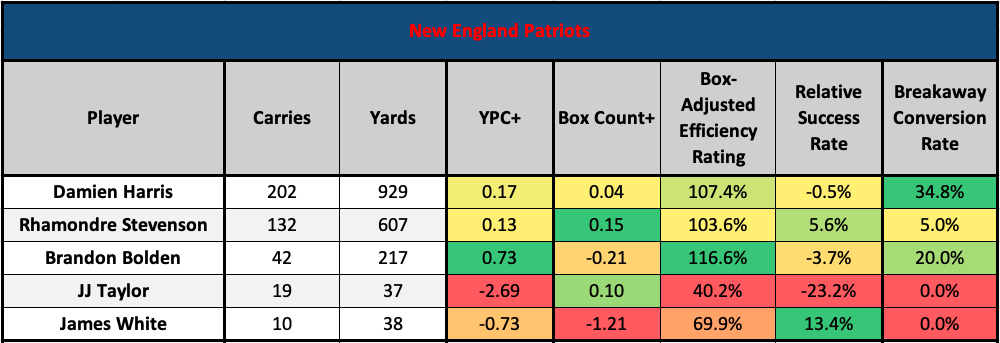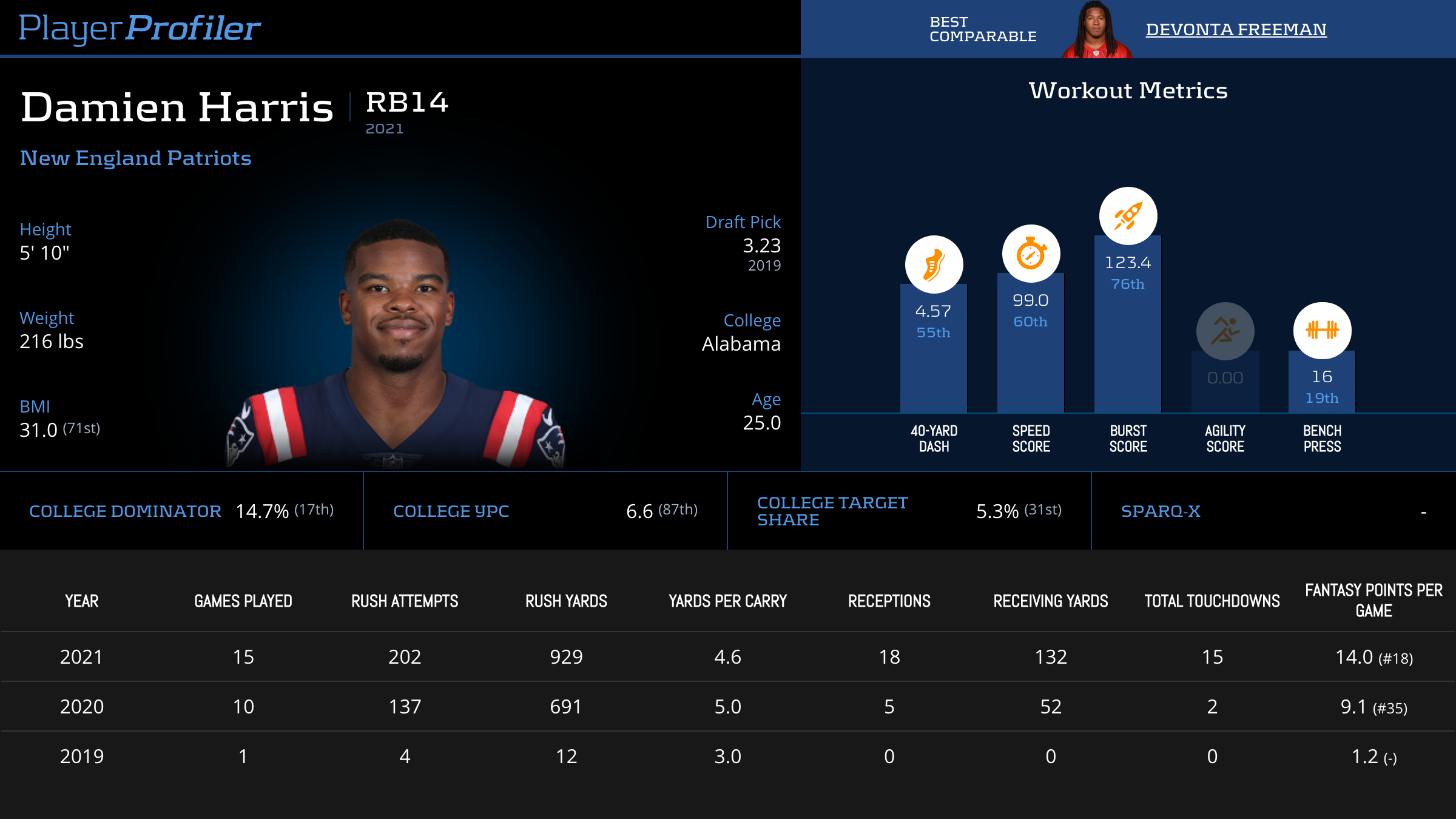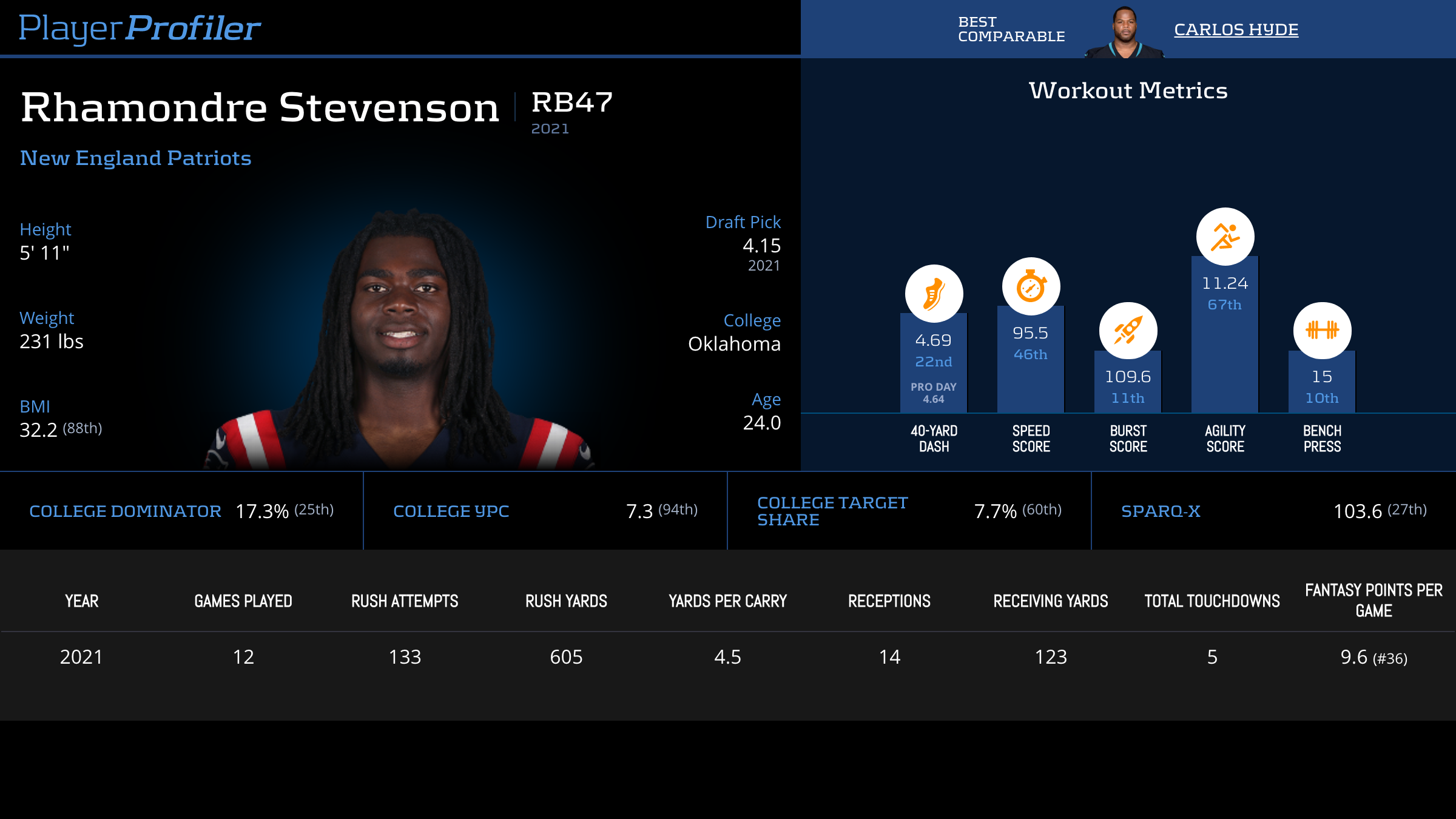This article will kick off an offseason series in which I will take a deep dive into one NFL team’s backfield and examine the respective rushing performances of the players in it. In doing so, I hope to gain insights into key players from a talent evaluation standpoint, and using that evaluation as a baseline, from a dynasty valuation standpoint.
I’ll start by taking a quick overview of each team’s raw rushing volume and propensity to run the ball in general, and then dive into the player evaluation portion. Before we start, let’s define the metrics I’ll use as part of those evaluations:
Key Metrics
Yards per Carry+ (or YPC+)
The degree to which a player’s raw yard per carry average exceeds or falls short of the collective yard per carry average of all other running backs on his team. Meant to be an overview of a player’s team-relative efficiency.
Box Count+
The degree to which the average amount of defenders in the box that a player faces on his runs exceeds or falls short of the collective average faced by the other running backs on his team. Considering that the outcome of any given rushing attempt is largely dependent on the amount of defenders in the box pre-snap, Box Count+ describes the relative degree of difficulty of a running back’s carries.
Breakaway Conversion Rate (BCR)
Quantifies performance in the open field by measuring how often a player turns his chunk runs of at least 10 yards into breakaway gains of at least 20 yards.
Box-Adjusted Efficiency Rating (BAE Rating)
Improves upon YPC+ by accounting for the box counts that a player carried the ball against. Looks at team-relative yards per carry against each individual box count, then uses a weighted average (based on total carries against each box count) to generate an overall score. A score of 100-percent indicates that a player is producing exactly the per carry output of his teammates, a score above 100-percent indicates that he is outdoing their per carry output to whatever degree, and vice versa for a score below 100-percent.
Relative Success Rate (RSR)
Measures player consistency using Success Rate, but relative to his teammates and adjusted for the box counts that he faced in the same way that BAE Rating is. “Success” on a given carry is defined by gaining 40-percent of yards needed on first down, 70-percent of yards needed on second down, and 100-percent of yards needed on third or fourth down. A score of 0.0-percent indicates that a player is succeeding on exactly the same percentage of his carries as are the other backs on his team, a positive score indicates that he is succeeding more often than his teammates are, and vice versa for a negative score.
Team Rushing Volume
In 2021, the New England Patriots ran the ball 489 times; the eighth-highest mark in the NFL and a little greater than two carries more per game than the league average. Further, according to rbsdm.com, they were No. 6 in the league in early down run rate (54.1-percent) in the presence of neutral Game Scripts (when win probability for either team did not exceed 80-percent). Also according to rbsdm.com, the Patriots opted to run the ball more than would be expected (based on play call data for all NFL teams) in nearly every down-and-distance situation. And they did so 8-percent more often than expected on aggregate.
New England is simply a run-heavy team, and they have been since Tom Brady left following the 2019 season. In 2020, they were No. 3 in the NFL in rushing attempts and No. 2 in early down run rate. Even in Tom Brady‘s final season with the team, they were top-10 in rushing attempts and still just middle-of-the-road in early down run rate. While the development of Mac Jones and the departure of long-time offensive coordinator Josh McDaniels might mean a slight change in gameplan, the Bill Belichick establishment is still holding strong. And it’s probably reasonable to anticipate the Patriots rushing at least slightly more often than league average in 2022.
Efficiency Numbers
Patriot running backs carried the ball 405 times last season. All five contributors, Damien Harris, Rhamondre Stevenson, Brandon Bolden, J.J. Taylor, and James White, notched at least 10 totes. Here are the full rushing efficiency profiles for those five runners:
Let’s break down what these numbers mean.
Harris and Stevenson were the two main ballcarriers in New England, and both of them proved worthy of those roles. Despite higher box counts than their teammates, they both posted positive YPC+ numbers. They did have different journeys to that efficiency, however.
While more efficient relative to his teammates overall, Harris was actually less consistent than other backs on the team. He was able to leverage a high Breakaway Conversion Rate toward positive team-relative efficiency despite a negative Relative Success Rate.
Stevenson had nearly the opposite performance. The box counts he faced were the highest on the whole team. But he was both more efficient overall and significantly more consistent than his backfield mates. He was able to post those numbers despite creating next to no big plays; converting only one of his 20 chunk gains into a breakaway run.
Bolden was very efficient on low volume, while both Taylor and White were unimpressive in very limited roles.
So Now What?
I’m particularly interested here in the Damien Harris–Rhamondre Stevenson dichotomy. From both talent evaluation and dynasty valuation standpoints.
It’s clear from their 2021 efficiency metrics that they were both quality runners. But they made their respective impacts in different ways. Harris rode periodic big plays to plus efficiency. Stevenson consistently churned out positive yardage without the average-boosting benefit of breakaway runs.
My first question is: are these features of their performances a result of qualities inherent to the players themselves? Or are they one-off quirks based on a single season’s worth of carries? Let’s investigate.
Damien Harris
Damien Harris being a third-year player gives us previous NFL seasons to draw conclusions from. He only carried the ball four times as a rookie in 2019, so let’s focus on his 2020 numbers:
Coincidentally, his BAE Rating over the two seasons has been completely stable despite fluctuations in consistency and big play creation. It’s reasonable to say that despite an uptick in breakaway runs, his down-to-down performance as a runner took a slight dip in 2021 compared to 2020. He failed to produce at the same consistent rate relative to his teammates. All things being equal, which they literally are here given the identical BAE Ratings, I’d prefer my runners produce consistently than buoy their averages with occasional splash plays.
The disparity in performances here then begs the question of which is the real Harris? Given the small-sample nature of Breakaway Conversion Rate, it’s misguided to try to hone in on whether or not he’s “inherently” a big-play guy. It’s more likely that consistency is something inherent to a player given the quality of vision, mental processing, decision-making skills, and physical traits they possess that would enable them to regularly succeed relative to their teammates. Let’s zoom even further out and see what his college numbers say about him as a runner.
Over his Alabama career, he posted a 0.27 (39th-percentile among backs drafted since 2007) YPC+ and a -0.53-percent (33rd-percentile) Chunk Rate+. He had a 33.3-percent (62nd percentile) Breakaway Conversion Rate. Box count data is not available for his entire career. But here’s his rushing efficiency profile from his final season in 2018:
Along with the context of his career numbers at Alabama, those final season metrics look a lot like his performance as a Patriot in 2021. Positive team-relative efficiency despite lower consistency.
Rhamondre Stevenson
Rhamondre Stevenson was a rookie last season, so the only historical context to his 2021 performance comes from his college career. Here is his rushing efficiency profile from his two years at Oklahoma:
So Again, Now What?
We have one year of clean comparison between these two players and another two years each of context to their respective rushing styles and performances. Going all the way back to his time at Alabama, Damien Harris has regularly outdone the per carry efficiency of his teammates. Though he has often failed to do so via down-to-down consistency. Rhamondre Stevenson has been both more efficient and more consistent than his teammates. And while he wasn’t a big-play guy last season, that was in his bag at Oklahoma.
For my money, Stevenson is the better player. He’s not as athletic, but that’s not really Harris’ game either. And in addition to the numbers indicating that he’s a more well-rounded runner, Stevenson also has an advantage as a pass-catcher.
Stevenson’s Receiving Chops
Going back to college, Rhamondre Stevenson earned a 12.7-percent (80th-percentile) Target Share. Which is rare for a 23o-pound dude. And significantly better than the 6.4-percent (23rd-percentile) mark that Damien Harris earned in college.
That comparison isn’t completely fair given that Stevenson occupied a larger role in the Sooner offense overall than Harris did for the Tide. But Stevenson was more involved as a receiver even when accounting for that disparity.
Satellite Score
Satellite Score is a metric that contextualizes receiving involvement for a player’s overall role in his team’s offense. Basically, it tells you that the 10-percent Target Share that Chris Thompson earned in college says more about his receiving potential than does the 10-percent Target Share that Rashaad Penny earned; considering Thompson posted his receiving numbers as part of a 17.7-percent (28th-percentile) Dominator Rating and Penny his as part of a 50.1-percent (98th-percentile) Dominator Rating. Appropriately, Thompson’s Satellite Score of 59.6 is a 94th-percentile mark, while Penny’s 27.1 lands in the 39th-percentile.
Rhamondre Stevenson‘s college Satellite Score was an 86th-percentile mark of 48.8, while Damien Harris‘ 38.3 is a 69th-percentile mark. Stevenson also bested Harris in most receiving efficiency numbers. Including yards per reception (11.7 to 9.3), yards after the catch per reception (12.6 to 10.8), and yards per target (8.4 to 7.3).
As professionals, those numbers have continued to favor Stevenson. And while both of them have not been very involved in the Patriots passing game (New England tends to have compartmentalized roles for their runners, and neither have been been the primary receiving backs), Stevenson has been more so. Harris’ seasonal Target Share numbers have been 2.5-percent in 2020 and 4.4-percent in 2021. While Stevenson posted a 4.8-percent in 2021. Given their respective Dominator Ratings, those numbers produce Satellite Scores in the 8th-percentile for Harris (in both ’20 and ’21) and in the 24th-percentile for Stevenson.
For Real This Time, Now What?
Rhamondre Stevenson has the edge on Damien Harris as both a runner and receiver. It’s a slight edge in both cases, and the book isn’t closed on these players relative to each other. But that edge does exist. I had Stevenson rated slightly higher as a prospect than I did Harris. And nothing they’ve done so far in the NFL is cause to change that evaluation.
As producers, they’re pretty even. Harris hardly played at all as a 22-year old rookie. He then posted a 16.4-percent Dominator Rating as a second-year guy and a 27.7-percent Dominator Rating in 2021. Stevenson’s 16.0-percent Dominator Rating as a 23-year old rookie is essentially the same mark that Harris posted in his age-23 season.
Based on the season Harris just put together (he finished as the RB14 in PPR, and his Dominator Rating is an 85th-percentile mark for 24-year-olds), it’s pretty reasonable that he’s being selected ahead of Stevenson in dynasty leagues. Per DLF, Harris is currently the RB31 with a mid-7th round ADP. Stevenson is going 8.5 picks later as the RB33. Per KTC, Harris is the RB29 and Stevenson is the RB32.
Situations are fluid and very difficult to predict. So I’m betting on the talent advantage I perceive Stevenson to have over Harris winning out in the long run. He’s also a year younger and is signed with New England through 2024. Harris will be a free agent following the 2022 season.
Other players under contract in that backfield are Devine Ozigbo, Malcolm Perry, and J.J. Taylor. All three of those players are currently just signed through this next year. While both James White and Brandon Bolden are free agents. It’s certainly possible that New England looks to add talent and depth this offseason.
Final Word
If I’m on the clock in the middle rounds of a dynasty startup, I’m probably letting somebody else pull the first trigger on a Patriot running back before I scoop up the other guy. If I’m holding Damien Harris on an existing roster, I’m looking to pivot to Rhamondre Stevenson through trade while adding some sort of rookie pick or lottery ticket taxi stash. The difference is small, but I think Stevenson is the better long-term bet.









